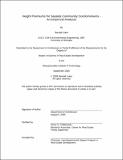| dc.contributor.advisor | Henry O. Pollakowski. | en_US |
| dc.contributor.author | Loker, Randall (Randall David) | en_US |
| dc.contributor.other | Massachusetts Institute of Technology. Dept. of Architecture. | en_US |
| dc.date.accessioned | 2006-06-20T12:55:32Z | |
| dc.date.available | 2006-06-20T12:55:32Z | |
| dc.date.copyright | 2005 | en_US |
| dc.date.issued | 2005 | en_US |
| dc.identifier.uri | http://hdl.handle.net/1721.1/33197 | |
| dc.description | Thesis (S.M.)--Massachusetts Institute of Technology, Dept. of Architecture, 2005. | en_US |
| dc.description | This electronic version was submitted by the student author. The certified thesis is available in the Institute Archives and Special Collections. | en_US |
| dc.description | Includes bibliographical references (leaf 54). | en_US |
| dc.description.abstract | This thesis investigates the value that condominium buyers in oceanfront communities place on how high above the ground their home will be. It is assumed that buyers will pay a premium for height, but to date no study has been performed to quantify what that value is, and how it changes throughout the height of a given building. A semi-log regression equation is employed to isolate the impact of vertical location on price, and as expected, price does increase with floor height. The regression results conclude that for oceanfront buildings, condominium prices (relative to floors 1-10) are 6.1% higher for floors 11-20, 12.8% higher for floors 21-30 and 13.5% higher for floors 31-40. For buildings on Biscayne Bay or the intercoastal waterway, condominium prices are 7.7% higher for floors 11-20, relative to the ground floors, and 9.1% higher for floors 21-30. The data for this study comes from the Miami Beach, Florida MLS database including transactions occurring from June 2003 through May 2004 on condominiums within a 5-mile radius of South Beach, the area's most valuable real estate. The results should be applicable to other oceanside communities, but not necessarily to urban centers where the relationship between height and view is likely to be significantly different. | en_US |
| dc.description.statementofresponsibility | by Randall Loker. | en_US |
| dc.format.extent | 54 leaves | en_US |
| dc.format.extent | 783555 bytes | |
| dc.format.extent | 783368 bytes | |
| dc.format.mimetype | application/pdf | |
| dc.format.mimetype | application/pdf | |
| dc.language.iso | eng | en_US |
| dc.publisher | Massachusetts Institute of Technology | en_US |
| dc.rights | M.I.T. theses are protected by copyright. They may be viewed from this source for any purpose, but reproduction or distribution in any format is prohibited without written permission. See provided URL for inquiries about permission. | en_US |
| dc.rights.uri | http://dspace.mit.edu/handle/1721.1/7582 | |
| dc.subject | Architecture. | en_US |
| dc.title | Height premiums for seaside community condominiums : an empirical analysis | en_US |
| dc.type | Thesis | en_US |
| dc.description.degree | S.M. | en_US |
| dc.contributor.department | Massachusetts Institute of Technology. Department of Architecture | |
| dc.identifier.oclc | 66143906 | en_US |
